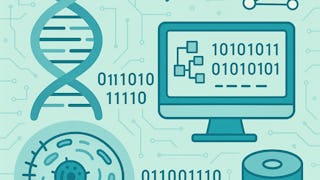Le cours donne un aperçu général et principalement pratique des compétences fondamentales pour la bio-informatique (et, en général, l'analyse des données). L'objectif est de soutenir le développement simultané de compétences quantitatives et de programmation pour les étudiants en biologie et en biomédecine ayant peu ou pas d'expérience en programmation ou en analyse quantitative.

Profitez d'une croissance illimitée avec un an de Coursera Plus pour 199 $ (régulièrement 399 $). Économisez maintenant.

Compétences fondamentales en bioinformatique



Instructeurs : Jesper Tegner
14 346 déjà inscrits
Inclus avec
(90 avis)
Expérience recommandée
Ce que vous apprendrez
Les bases de R
Les bases de Python
Comment analyser les données de comptage de l'ARNseq en vrac ?
Comment analyser les données de comptage de l'ARNseq d'une seule cellule ?
Compétences que vous acquerrez
- Catégorie : Programmation en Python
- Catégorie : Rmarkdown
- Catégorie : Manipulation de données
- Catégorie : NumPy
- Catégorie : Pandas (paquetage Python)
- Catégorie : Bioinformatique
- Catégorie : Qualité des données
- Catégorie : La programmation en R
- Catégorie : Analyse statistique
- Catégorie : Analyse des Données
- Catégorie : Analyse exploratoire des données (AED)
- Catégorie : Unix
- Catégorie : Commandes Unix
- Catégorie : Tests d'hypothèses statistiques
- Catégorie : Visualisation scientifique
Détails à connaître

Ajouter à votre profil LinkedIn
13 devoirs
Découvrez comment les employés des entreprises prestigieuses maîtrisent des compétences recherchées

Il y a 4 modules dans ce cours
Le premier module explorera les bases de la programmation à l'aide de R. Il s'agira notamment de travailler avec R et RStudio, de comprendre les types de données, les boucles et les " ifs ". En outre, le module fournira une introduction à RMarkDown en tant qu'outil de partage de code que nous utiliserons dans les cours de codage.
Inclus
17 vidéos2 lectures4 devoirs
Le deuxième module se concentrera sur deux objectifs. Premièrement, maîtriser l'utilisation des valeurs logiques et des vecteurs et leurs applications dans le contrôle de la qualité. Deuxièmement, mettre en pratique les compétences de programmation tout en apprenant à effectuer des analyses statistiques de base. Cela comprendra : l'analyse exploratoire des données, la corrélation, les modèles linéaires, le test T et l'ANOVA. Enfin, nous explorerons les ressources disponibles pour la programmation R.
Inclus
20 vidéos1 lecture2 devoirs6 devoirs de programmation
Le troisième module présente les bases du langage de programmation Python. Tout d'abord, le module comparera les langages Python et R et apprendra la syntaxe de programmation de Python. Ensuite, le module travaillera avec deux modules clés de Python : pandas et numpy.
Inclus
19 vidéos1 lecture4 devoirs4 devoirs de programmation1 laboratoire non noté
Le dernier module se concentrera sur l'application des connaissances et de la compréhension de la programmation dans l'analyse des données réelles d'ARN-seq. R sera utilisé pour l'analyse de l'ARN-seq en vrac et Python pour l'ARN-seq unicellulaire. Les résultats des deux analyses seront ensuite intégrés. Enfin, le module fournira des indications sur la manière d'acquérir des connaissances et des compétences plus approfondies en R.
Inclus
19 vidéos2 lectures3 devoirs4 devoirs de programmation
Instructeurs

En savoir plus sur Analyse des Données
 Statut : Prévisualisation
Statut : PrévisualisationBirla Institute of Technology & Science, Pilani
 Statut : Prévisualisation
Statut : PrévisualisationUniversity of California San Diego
 Statut : Essai gratuit
Statut : Essai gratuitUniversity of California San Diego
 Statut : Essai gratuit
Statut : Essai gratuitUniversity of Toronto
Pour quelles raisons les étudiants sur Coursera nous choisissent-ils pour leur carrière ?




Avis des étudiants
90 avis
- 5 stars
66,66 %
- 4 stars
16,66 %
- 3 stars
8,88 %
- 2 stars
2,22 %
- 1 star
5,55 %
Affichage de 3 sur 90
Révisé le 18 juin 2025
Thanks for the team who made this valuable course. All the best!
Foire Aux Questions
Pour accéder aux supports de cours, aux devoirs et pour obtenir un certificat, vous devez acheter l'expérience de certificat lorsque vous vous inscrivez à un cours. Vous pouvez essayer un essai gratuit ou demander une aide financière. Le cours peut proposer l'option "Cours complet, pas de certificat". Cette option vous permet de consulter tous les supports de cours, de soumettre les évaluations requises et d'obtenir une note finale. Cela signifie également que vous ne pourrez pas acheter un certificat d'expérience.
Lorsque vous achetez un certificat, vous avez accès à tous les supports de cours, y compris les devoirs notés. Une fois le cours terminé, votre certificat électronique sera ajouté à votre page de réalisations - à partir de là, vous pouvez imprimer votre certificat ou l'ajouter à votre profil LinkedIn.
Oui, pour certains programmes de formation, vous pouvez demander une aide financière ou une bourse si vous n'avez pas les moyens de payer les frais d'inscription. Si une aide financière ou une bourse est disponible pour votre programme de formation, vous trouverez un lien de demande sur la page de description.
Plus de questions
Aide financière disponible,







